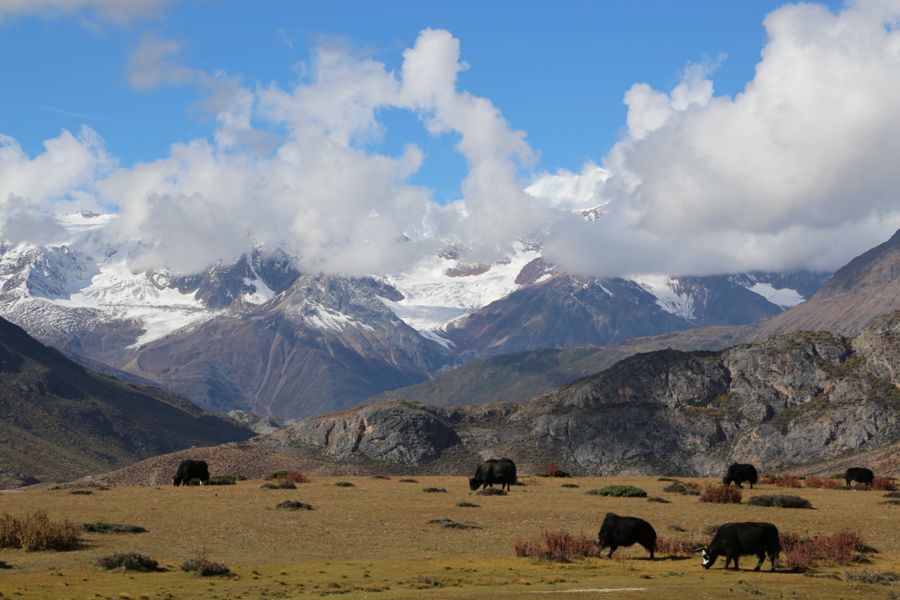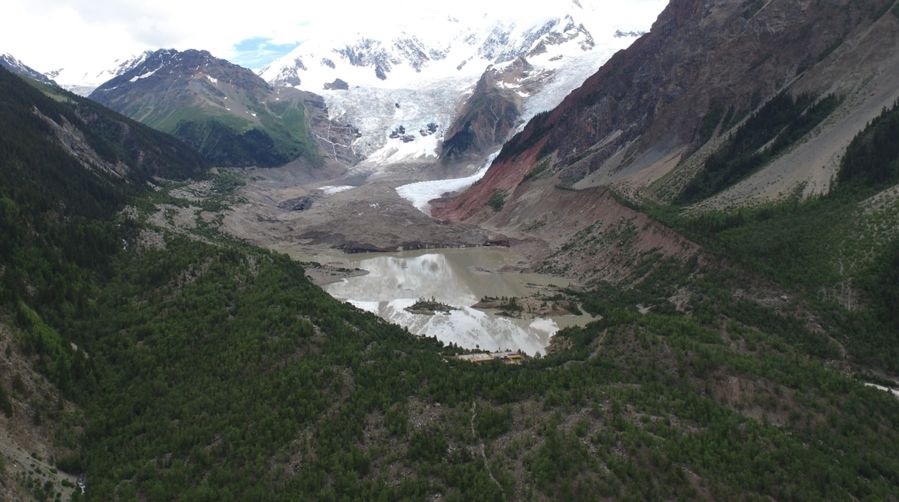
Researchers drill timber core samples in Tibet, July, 2018. (Photo provided to Xinhua)
Zhu calls himself a "tree talker". For him, reading tree rings is like developing a roll of camera film, which records the past and hides the glaciers' future.
by Xinhua writer Yuan Quan
BEIJING, March 12 (Xinhua) -- Zhu Haifeng, 42, talks to trees and learns about our planet's past.
Zhu uses tree ages, rather than high-tech instruments, to study glacier changes that happened centuries ago on China's Qinghai-Tibet Plateau, sometimes known as "the Third Pole."
Glaciers are silent, but trees can talk. The concentric rings in tree trunks are their language, Zhu says.
The rings can tell a tree's age, with one ring signifying each year, and the outside rings, near the bark, are the youngest. The rings also reflect climatic conditions of when they were formed.
"Cold might result in a narrow ring, while a warm year might result in a wide one," Zhu says. "If a stone hits a tree, it will leave a scar in the rings."
The age and growth of trees reflect the movement of glaciers.
Since 2009, the professor at the Institute of Tibetan Plateau Research of the Chinese Academy of Sciences, has been looking for clues on the glacier forefields, the landscape formed by retreating glaciers. As a glacier melts, the glacier bed is released, and new tree species begin to grow. The oldest trees on such sites are used to calculate when it retreated.

Zhu Haifeng in Tibet, July, 2018. (Photo provided to Xinhua)
Zhu calls himself a "tree talker". For him, reading tree rings is like developing a roll of camera film, which records the past and hides the glaciers' future.
Glaciers store about 69 percent of global freshwater. The Qinghai-Tibet Plateau, with tens of thousands of glaciers, is the headwaters of multiple rivers in Asia, providing water for billions of people. However, the glaciers are melting rapidly in the warming climate. The effects can be felt thousands of miles away.
"Glaciers and human destiny are closely linked. Predicting the glaciers' future is predicting our future," Zhu says.
Every year, Zhu and his colleagues spend two months looking for trees on the cold, bleak terrain. They camp in the snowy mountains, battered by icy winds and gasping for breath in the thin air.
Due to the remote and harsh environment, glacier observations on the plateau are infrequent. Most previous studies are based on satellite data, providing only about 30 years of temporal coverage.

The Qinghai-Tibet Plateau, with tens of thousands of glaciers, is the headwaters of multiple rivers in Asia. (Photo provided to Xinhua)
Zhu says finding a suitable tree requires professional knowledge and perseverance, because not every tree can speak on behalf of a glacier. Only the oldest, injured or dead trees have the most accurate ring records.
Instead of cutting trees, Zhu gets cross sections of tree rings by drilling timber core samples. In the coring process, a sample is collected intact in a hollow, narrow steel tube. In the laboratory, researchers will use special techniques and equipment to inspect and analyze it.
"The wound left by this method is the size of a drill hole, which has little effect on the tree. It will soon secrete resin to block it," Zhu says.
The trees are safe, but the researchers can be at risk.
In 2011, Zhu and his colleagues were besieged by villagers when drilling trees during an expedition in Tibet. The villagers could not speak Mandarin well, and they thought Zhu, with his big bushy beard, was an illegal wood dealer trying to destroy the forest. Zhu had to call the police before his team could leave.
Finding trees is not easy. Researchers often take detours, drive into bogs and got lost in heavy fog. Most have suffered altitude sickness.
"We looked for a thousand trees, but only a dozen were useful," Zhu recalls.
For Zhu, scientific research requires rationality as well as emotion. Whenever he feels overwhelmed by troubles, Zhu encourages himself to persist by writing poetry and singing.
"In the middle of the world, several mountains surround the Plateau," wrote Zhu. "If you come here, better not hurry. Hold your breath, enjoy the silence. People here roll the prayer wheels, praying for safety for the world; People here raise prayer flags, sending blessings to the world. Tashi Delek. Tashi Delek."

Ages of the oldest trees on the glacier forefields are used to calculate when a glacier retreated. (Photo provided to Xinhua)
Research is hard, but worth it. Zhu has studied how more than 30 glaciers have changed over hundreds of years on the plateau. The results have been published in many international scientific journals.
"These results also suggest it is possible to use tree data to understand how long-term glacier dynamics respond to global warming," Zhu says. "My little daughter once asked me why I go to the plateau to look at trees as there are so many in Beijing."
"I told her that the trees on the plateau can tell stories." ■



